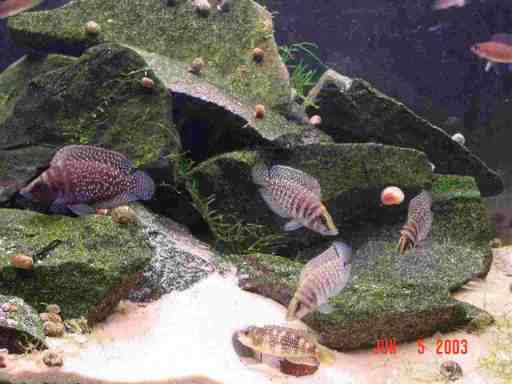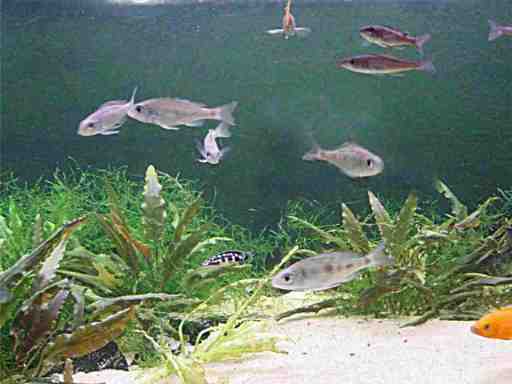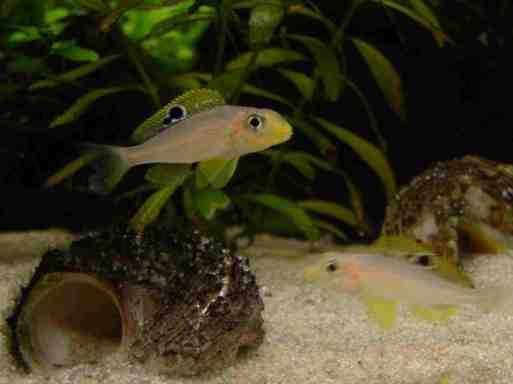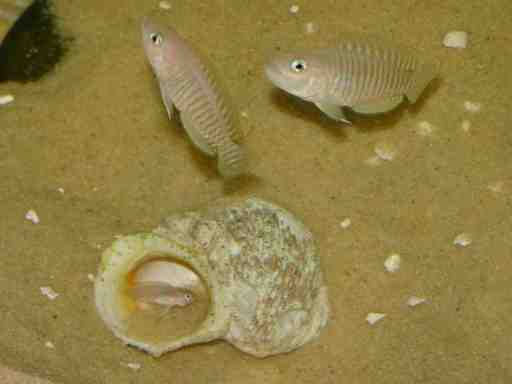

fighting over the same territory.
There are generalists, which move within a wide range of habitats and specialist, which are limited to very specific niches. For the most part, generalists can survive within most habitats, can catch and consume a wide variety of foods, have wider temperature and water condition ranges, and has less strict breeding conditions. At first glance, being a generalist is not a bad strategy for any creature to follow. With all things being equal, the lake would be populated by all species in equal numbers, living in harmony. But what if one species was able to catch a certain type of food better, (i.e. the pointed mouth on a Julidochromis used for picking tiny shrimps out of rock crevices), or eat something that no one else wanted to (i.e. the vegetarian diet of Tropheus with their extended digestive track for better nutrient adsorption). What if a species was able to out wit predators by hiding in a specific place (i.e. Neolamprologus shell dwellers), or swim faster (i.e. The streamlined shapes of Cyprichromis including an extra large swim bladder for quick diving) or develop tougher scales (i.e. The slow growing, heavily armored Altolamprologus). What if a fish was to specialize and develop a better strategy for parental care such as mouth brooding. Then what we have is a specialist, who lives in a very specific niche and is successful at its lifestyle. A specialist would not be able to survive or reproduce very well outside of its niche. This is not to say that one strategy is better then another, but all must be considered while preparing your aquariums layout.
There are quite a few species, which have evolved a lifestyle living in the open waters of the lake. These include fishes such as Cyathopharynx and Cyprichromis, all living without any cover. The strategy of Cyprichromis, the smallest and fastest of the two examples, include high speed, the ability to dive up and down the water column quickly, and plenty of endurance for constant movement. All this requires frequent feeding. Their only defense would be to hide within a school to confuse and avoid predators. Of course plenty of open water is preferred and the individual males seem to hold a three dimensional territory 1 to 2 feet across, with subordinate males and females schooling in between.
Some of our favorite fishes make their homes along the sand beds. Open sand wanderers include monogamous Xenotilapia and polygamous Enantiopus. Drab looking juveniles form schools which aimlessly search the open dunes for food. For the Enantiopus, once they have attained adulthood, the males dons their mating colors and begin holding territories. They then attempt to attract as many females as they can into their nest. Regardless of whether you have a single male displaying, or a breeding pair of Xenotilapia, their territory would contain a pit or saucer shaped nest with a diameter of at least 6 inches. Enough space should be provided and the absolute minimal would measure at least 10 to 12 inches across. This is not to say that keeping an open square foot of sand in the middle of your aquarium is enough, but that there should not be other neighboring aggressive fishes within range, intruding into the potential nest. For example, a breeding pair of Neolamprologus brichardi who have made their home within a cave facing the sandy plain will venture at least 6 inches away from their home, putting them right in the middle of a potential Xenotilapia nest. Thus a buffer zone surrounding the territory with a radius of 3 to 6 inches is required.
Other fishes which inhabit the sandy dunes includes shell dwellers, most of which are in the Lamprologus genus, such as ocellatus, multifasciatus and brevis. These fishes are restricted to living in or around empty snail shells and the same general territory requirements abet smaller, are needed. Some species, such as the colonial multifasciatus have been observed living in shells 4 inches apart form one another, whereas pearly ocellatus cannot stand being within site of each other and need to be at least 2 feet apart. This distance can easily be shortened by placing a rock or a sandy hill in between, which will obstruct their line of sight. Using this trick, they would live happily in a rather dense arrangement. A large buffer zone around their shell is absolutely critical, otherwise larger tankmates would prevent the little shelldwellers from leaving their shell and they would eventually starve. The shells may vary in size from as little as an inch to 3 inches in diameter.
The last and most popular group of fishes inhabit the rocky habitat. These include Neolamprologus, Julidochromis and Tropheus. Oh the whole, these fishes, especially Julidochromis, like plenty of rockwork and won't venture too far from their home. It is possible to segregate separate populations by placing rock piles as far apart from each other as possible, with plenty of open space in between. Once they have found a home and established a territory, it's possible to introduce a new rock pile along with some new fish to claim it. For a rock pile to be chosen, the caves and crevices should be as small as possible to give them privacy and shelter from larger fishes. Intraspecific competition between the same species can be fierce, however individuals and breeding pairs are much more tolerant of neighboring fish which look completely different. For example, it is almost impossible to place a pair of Neolamprologus brichardi immediately adjacent to a pair of Neolamprologus pulcher, unless there was a very defensive Neolamprologus leleupi in between to separate them. This being said, it is possible to for adjacent territories to be as small as 8 to 12 inches across, however they must be large enough for the buffering fish to feel comfortable in. Otherwise the constant harassment would simply force the buffering fish to abandon its territory.




